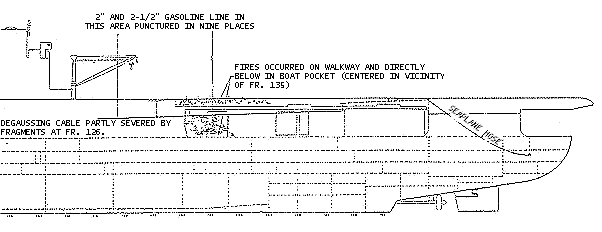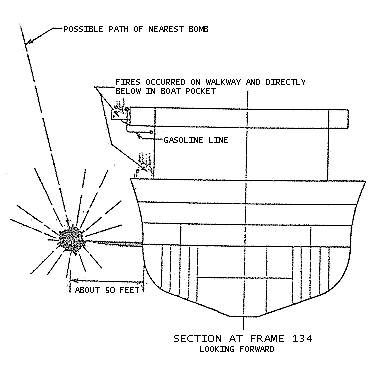History:
Prewar -
1941 -
1942 -
1943 -
1944 -
1945 -
Postwar
The Ship -
All Hands -
Decorations -
Remembrance
Home > Action Reports and Logs >
About 1:40 PM on 1 February 1942 while operating in the northeastern Marshalls, Enterprise was approached on the starboard bow by five Japanese twin-engined land planes flying at 10,000 feet. While in a shallow power dive to about 3,500 feet, each plane released three bombs. Enterprise was maneuvered at high speed and all bombs fell beyond the ship, the nearest about 50 feet off the port quarter at frame 130. The bombs were estimated by the ship to be general purpose with instantaneous fuzes, weight between 100 and 200 pounds. Splashes were 100 to 125 feet high. Slight shock was felt throughout the ship, similar to that caused by firing the ship's guns.

Fragments from the attack opened four 1/2-inch holes in the 1/4-inch medium steel plating of the port hangar bulkhead between frames 130 and 133 and six holes in the hangar roller curtain. The externally fitted 2 to 2 1/2-inch gasoline line was pierced by fragments in nine places between frames 119 and 135. The M-1, M-2 and M-6 coils of the externally fitted degaussing cable at frame 126, and fifteen minor electrical cables were pierced or severed by fragments or destroyed in the gasoline fire.

Gasoline from the pierced gasoline line caught fire either from hot fragments or electrical short circuits and the fire spread over the port gallery walkway and the boat pocket between frames 130 and 144.

Flames from the gasoline fire consumed canvas covers, splinter mats, airplane fueling hose, rubber deck matting, life jackets and pain on the deck and bulkheads. Although the fire seemed very threatening, it was soon extinguished with chemical foam from pressure-operated foam generators (phomene accumulators). By quick and effective use of the available firefighting apparatus, Enterprise repair parties successfully passed their first real test.

Although the gasoline fire developed as a result of penetration of the exposed portion of the gasoline piping by fragments, no change in its location was seriously considered. It would have been impracticable to give adequate protection to this main, and a fire on the gallery walkway was obviously preferable to one in the hangar. Although internal fitting of degaussing cables had become standard practice, Enterprise could not be so fitted until her extensive 1943 overhaul.
Diagrams derived from Bureau of Ships, Navy Department, blueprints provided courtesy Arnold Olson, Public Affairs Officer, USS Enterprise CV-6 Association. Narrative derived from War Damage Report No. 59, "U.S.S. Enterprise (CV6) War History", Bureau of Ships, Navy Department.
Image Library -
Action Reports and Logs -
News Stories
Message Boards -
Bookstore -
Enterprise CV-6 Association
Copyright © 1998-2003 Joel Shepherd ([email protected])
Sources and Credits